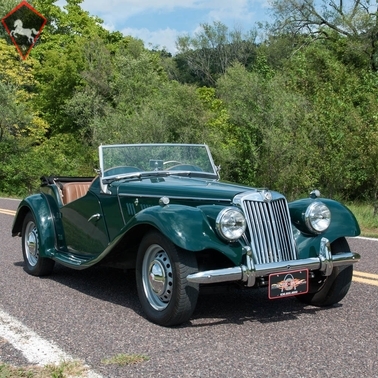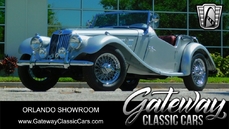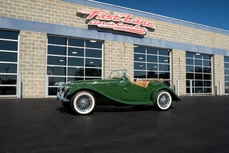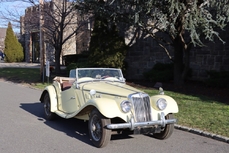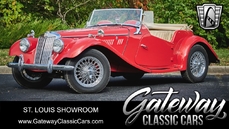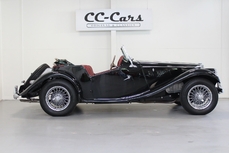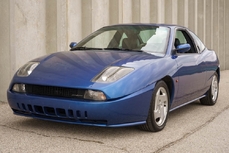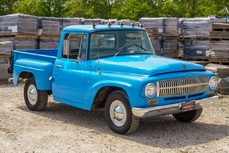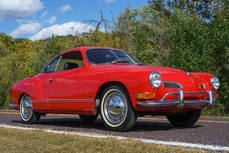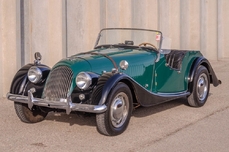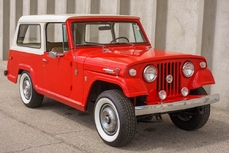MG TF Inline four 1954
Allgemeine Beschreibung :
1954 MG TF 1250 Roadster
Thoroughly and professionally restored!
Green exterior with black manual top and Biscuit-colored interior72
1250cc four-cylinder engine
Four-speed manual transmission with synchromesh on gears 2, 3 and 4
15-inch vented wheels with MG hubcaps
Car comes with spare parts and owner’s manual and other documentation
Often referred to as ‘the last of the square riggers,’ MotoeXotica Classic Cars is pleased to offer this 1954 MG TF Roadster. The Rover TF gained the square rigger moniker due to its very strong resemblance to the pre-war Midgets.This particular MG has undergone a professional restoration with lovely presentation. This is a beautiful and original car and an excellent candidate for any collection in need of an early post-World War II piece!
Dressed in green, the car’s paint is in excellent shape, as is the windshield and the vehicle’s lights. The car rolls on Metric Radials, 165R15, surrounding 15-inch vented wheels with MG hubcaps, which shimmer in the sunlight. The bumpers fit well and show very well. All of the body panels are in good order, the engine bay is tidy and the battery looks new. This TF is powered by a 1250cc XPAG overhead valve four-cylinder engine making 57 horsepower and the engine is linked to a four-speed manual transmission.
For those in the know, it was no secret that the TF was a stopgap measure due to a delay in putting the long-awaited MGA into production.This was due entirely to Leonard Lord, the BMC managing director who favored the proposal put forth by Donald Healey for his Healey 100. Lord considered the MGA and Healey too similar and it was for this reason that the TF became part of MG history.Many motoring journalists thought that the TF would be a non-starter, particularly with such a varied sports car selection available to prospective purchasers. However, even in the light of this stiff competition and the fact that the TF was only intended as a stopgap, sales of the two TF versions, 1250cc and 1500cc, totaled 9,602 in 19 months, including two prototypes and 3,400 TF1500s, which was a creditable achievement. Production ended at chassis number TF10100 on April 4, 1955. The TF was superseded by theMGA.
The TF Midget, launched on October 15, 1953, was a face-lifted TD, fitted with the TD Mark II engine, headlights faired into the fenders, a bow-fronted grille concealing a separate radiator and a new pressurized cooling system along with a simulated external radiator cap.The bonnet also had a marked forward slope achieved by lowering the radiator shell three and a half inches in relation to the scuttle top. The front wings were also restyled to accommodate faired in headlamps instead of the traditional bolt on fixings on the wing stays as on the TD. The wings in turn were faired into the bonnet sides which all in all helped to create a new streamlined image. The rear of the car received some general restyling with modifications to the fuel tank and spare wheel mounting to help tidy up the overall appearance of the car. The end result was a car very pleasing to the eye.
Inside, and in keeping with the external modifications the cockpit layout was quite radically changed to that of its predecessor. A combination of items taken from the Y-series saloons, the TD and some items exclusive to the TF formed a comfortable and pleasant cockpit. Individual adjustable seats were provided in place of the normal bench type seating. The fascia panel was completely new with a welcome return to octagonal instrumentation. This was positioned centrally to allow easy construction of either a left or right hand drive model, many customers complained however that the rev counter was too far away for easy reading. Despite being advanced over its predecessors with many innovative additions, there was still no fuel gauge, which surprised many would-be purchasers. Otherwise, the instrumentation was quite comprehensive with an oil pressure gauge, temperature gauge, ammeter and clock.
Inside this example, the Biscuit-colored bucket seats are in fantastic condition, as is the carpet, which complements the seats. The dash, with its center-mounted, octagonal Jaeger gauges is in great condition as is the three-spoke steering wheel. The car’s door panels, center console and shifter are all in good condition. This car is a radio delete model.
Deciphering the VIN – HDC462303 – the first two digits, HD, designate this as a MG and an open two-seater; the next digit, C, indicates the color of the car when it left the Abingdon factory. This example was originally painted MG Red. Next, the “4” means the car was built as a left-hand drive unit for North America. The next digit, 6, indicates a cellulose body with synthetic fenders. The final digits, 2303, are this vehicle’s chassis number.
Competitors to this MG TF in 1954 including Healey’s 100, Triumph’s TR2, Jaguar’s XK120 and Morgan’s Plus 4. This MG comes with spare parts, an owner’s manual and other documentation.
This classic MG TF roadster will give any collection a touch of class and European flair, especially with its tasteful restoration! GET OUT AND DRIVE!!!
This car is currently located at our facility in St. Louis, Missouri. Current mileage on the odometer shows 72,282 miles. It is sold as is, where is, on a clean and clear, mileage exempt title.
VIN: HDC462303; EIN: XPAG TF/32207 (The XPAG TF indicates the 1250 model with 32207 as an engine sequence number).
http://www.motoexotica.com/inventory/listing/1954-mg-tf-convertible/
1954 MG TF Inline four is listed verkauft on ClassicDigest in Fenton (St. Louis) by for $34900.
Fakten der Auto
Karosserietyp : Auto Marke : MG Modell : TF Ausführung : Inline four Hubraum : 0.0 Modelljahr : 1954 Karosstyp : Convertible Lage : Fenton (St. Louis)
Verkauft
Angaben Zum Verkäufer
Verkauft
People who viewed this MG TF also viewed similar MG listed at ClassicDigest
Other cars listed for sale by this dealer
über MG
Die Geschichte von MG (Morris Garages) ist ein reiches Geflecht, das mehrere Jahrzehnte umspannt und verschiedene Besitzer sowie Unternehmensstrukturen einbezieht. Hier ist eine Übersicht über die MG-Geschichte von ihrer Gründung bis zur schwierigen Phase unter der British Leyland (BL) Corporation, wobei wichtige Modelle und ihre Spezifikationen hervorgehoben werden:1. Gründung und frühe Jahre:
Gründungsjahr: 1924
Gründer: Cecil Kimber
Anfänglicher Fokus: Karosseriebau und Anpassung von Morris-Autos.
2. MG-Oktogon-Logo:
Das ikonische MG-Oktogon-Logo wurde eingeführt und repräsentiert die Fusion von MG mit Morris.
3. MG M-Type Midget (1929–1932):
Wichtige Merkmale:
Kompakter Zweisitzer.
Angetrieben von einem 0,8-Liter-Motor.
Der Beginn der Midget-Serie.
4. MG T-Series (1936–1955):
Wichtige Modelle:
MG TA, TB, TC, TD, TF
Wichtige Merkmale:
Roadster mit klassischem Design.
Erfolg im Motorsport, insbesondere in der Zeit vor und nach dem Zweiten Weltkrieg.
5. Nachkriegszeit und MG A (1955–1962):
Wichtige Merkmale:
Abkehr vom traditionellen Design.
Erster MG mit einem stromlinienförmigen, modernen Design.
Erhältlich als Roadster oder Coupé.
Angetrieben von einem 1,5-Liter-Motor.
6. MG B (1962–1980):
Wichtige Merkmale:
Klassisches Design britischer Sportwagen.
Erhältlich als Roadster oder GT-Coupé.
In großen Stückzahlen produziert.
Varianten inklusive des leistungsstarken MGC.
7. MG Midget (1961–1979):
Wichtige Merkmale:
Kompakter Sportwagen auf Basis des Austin-Healey Sprite.
Erschwinglich und beliebt.
Verschiedene Iterationen mit Motor-Upgrades.
8. MG C (1967–1969):
Wichtige Merkmale:
Eine leistungsstärkere Version des MGB mit einem 2,9-Liter-Reihensechszylinder.
Begrenzte Produktion.
9. Ära der BL Corporation (1968–1980):
Übernahme durch British Leyland (BL):
MG wurde Teil des größeren Konzerns British Leyland.
Schwierigkeiten bei der Qualitätskontrolle und Arbeitskonflikte.
Rückgang der Produktqualität und des Rufes.
10. MG MGB GT V8 (1973–1976):
Wichtige Merkmale:
Einführung eines werkseitig produzierten MGB mit einem V8-Motor.
Versuch, während schwieriger Zeiten Leistung in die Modellpalette einzuführen.
11. MG RV8 (1992–1995):
Wichtige Merkmale:
Begrenzte Produktion des Cabrios.
Wiederbelebungsversuch durch die Rover Group (Nachfolger von BL), um den klassischen MG-Geist wiederzubeleben.
Die MG-Geschichte während der Ära von British Leyland markierte eine schwierige Phase mit einem Rückgang von Qualität und Ruf. Dennoch bleibt die Marke weiterhin mit klassischen britischen Sportwagen verbunden.
